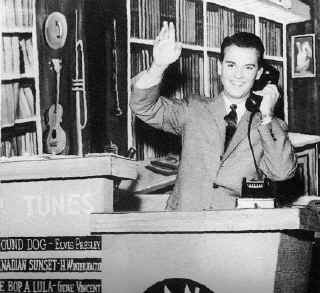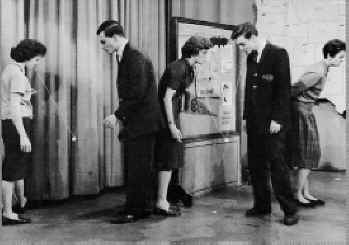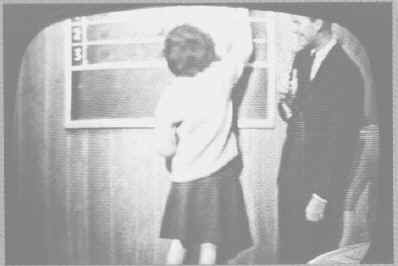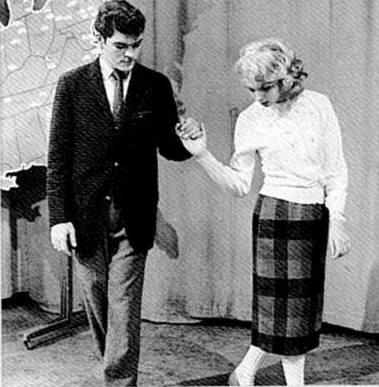|
|
|
|
Advertising on American Bandstand
|
|
|
|
With a college degree in advertising and an uncanny ability to speak to teenagers, Dick Clark was the perfect pitchman for sponsors whose products - from shampoo to acne medication to watches - were targeted at the adolescent market. In the late fifties, as the teenage market expanded and the number of teenagers jumped from seven million to twelve million, Clark shifted from local spokesman for Barr's, a popular Philadelphia jewelry store, to a national spokesperson doing endorsements for hair tonic, chewing gum and soda. He helped link up enough sponsors to make American Bandstand one television's most profitable daytime shows
Dance
Contests

![]()
One way to spotlight the songs, the dancers, and the dances on American
Bandstand was to hold dance contests. Kids in the
studio loved them, and the viewers did, too. The rules were
simple. Contestants had to sign up to get a number, then once a
week they pinned numbers on their backs, much like they did in
the dance marathons in the thirties. During the contests, viewers
cast ballots for their favorite dancers. Each contest lasted
three or four weeks, after which winners were announced on the
air. Several of the winners confessed that the voting was done
more on popularity merit. Still, they took their prizes, which
ranged from portable TVs to juke boxes.
|
|
|
|
As audiences for Bandstand grew, so did the stakes for the dance contest winners, who took home prizes that ranged from record albums to brand new cars. Here are pictures of the first-prize, a Ford Sunliner in the Pony contest won by Frani Giordano and Mike Balara.
|
|
|
Dorothy Horner and Frank Spagnoula won the Chalypso Contest in 1957. Paula Kopicko and Richie Cartledge won the 1962 Mashed Potato Contest
Original
Set

Dick Clark inherited the original set for American Bandstand
from Bob Horn's Bandstand, the show Clark took over in
1956. The painted background was that of a record shop of the
late forties or early fifties, when records were big, clunky 78
RPMs. Clark's high podium, like a bandstand, set him apart from
the dancers. The podium was donated to the Smithsonian Institute
in 1981.
Roll
Call

"Joanne seventeen South Philly," "Mark J, fourteen
Bartram High, "Scott fifteen, North Catholic." Roll
Call was a regular feature on American Bandstand and how
the viewers at home got to know the kids on the show. When the
show was only broadcast locally the kids gave the names of their
schools, as well as names and ages. When the show went national
in 1957, they gave their names, ages and their hometown.
Clues

Kids watching American Bandstand at home were looking
for any clues that signaled romance between kids on the show -
who danced with whom, how closely they danced, and how slow they
danced together. In the innocent fifties euphemisms for touching
and sex abounded in the American culture, especially in
television. Harmless games - where kids came into more innocent
contact with each other - spiced up the Bandstand program.
In this awkward moment, teens cooperated to eat up the string
attached to a marshmallow. Of course, if both partners succeeded
they came as close to kissing each other as was possible on a
show that morally towed the line.
Johnny
Mathis

Johnny Mathis signs autographs at the autograph table during his
October 15, 1957 debut on American Bandstand. For teens
who grew up in the late fifties, Mathis was the unchallenged
make-out king, whose silky smooth voice really filled a darkened
room. When Mathis released two singles in 1957, "Wonderful,
Wonderful" and "It's Not For Me To Say," teenagers
had their Frank Sinatra. The following year he had seven hits,
including the classic "Chances Are." His album, Johnny's
Greatest Hits (1958), the first of the greatest hits albums,
remained on the charts a record 490 weeks. Only Pink Floyd's Dark
Side of the Moon (1979) surpassed it.
Rate-A-Record

"It's got a great beat and you can dance to it." Those
immortal words came to represent the most popular feature of American
Bandstand, Record Review. The formula was simple: three kids
listened to three records and rated them between thirty-five and
ninety-eight. A fourth teen calculated the average, often with
the help of Dick Clark. The kids were usually right in their
judgments, picking scores of songs that became top ten winners,
demonstrating once again how their opinions counted.
Getting
Mail

Dick Clark and Frani Giordano
For millions of American teens who could not get to Philadelphia
to meet their favorite regulars in the American Bandstand
studio the next best thing was voting for them in one of the
shows many dance contests. The contests were a regular feature,
giving viewer's a chance to see their favorite couples and the
newest dances. Tens of thousands of fans sent their ballots to
American Bandstand, PO Box 5, PA. In a normal week, the show
received 45,000 letters. During the contests, 150,00 ballots
and letters came in, prompting Clark to joke that all the mail
bags in Philadelphia were being used to carry mail to show.
Halloween

With five shows a week, fifty-two weeks a year the producers of American
Bandstand had to come up with features to keep the show
fresh, interesting, and fun. One way was to celebrate Christmas,
New Year's, and Halloween. the Halloween shows were the most
amusing since they incorporated games, mask, and special guest
stars like the ghoulish Zacherle performing the novelty hit,
"Dinner With Drac " (1958) One of the most popular
games was musical chairs, where the masked teens rushed to find a
seat when the music stopped, and others ended up on the studio
floor. The thin line between childish and teenage behavior
sometimes evaporated with party games that were silly but
made for good fun and more importantly, better TV.
 |
 |
 |
One of the most popular dances created by the Bandstand crowd was the Chalypso, a combination of two popular fifties dances., the Cha-Cha and the Calypso. The simple dance could be done to songs as different as the Shirelle's "Will You Love Me Tomorrow" (19570 and Gene Pitney's "Every Breathe I Take" (1958). When the Chalypso became popular, several songs were written specifically for it; the most successful was Billy and Lillie's "La Dee Dah" (1957). These two dancers demonstrate the steps to Dick Clark.
Dancing
Couples

L-R: Carmen Jimenez,
Frankie Vacca, Norman Kerr, Joyce Shafer, Mike Balara, Frani
Giordano, Dick Clark
Jitterbug Dance Variations

The Jitterbug was one
of the popular dances on American Bandstand. It was demanding,
but it was fun. Here are three couple demonstrarting different
variations of the complex steps.
|
|
For many Americans growing up in the 1950s and early 1960s, American Bandstand was more than just a television show. It was a cultural ritual, a doorway to dreams, and a weekly spark of music, fashion, and youth. When the clock struck four, living rooms across the country lit up with rhythm, and teenagers everywhere kicked off their shoes or laced them tight—ready to dance.
![]()